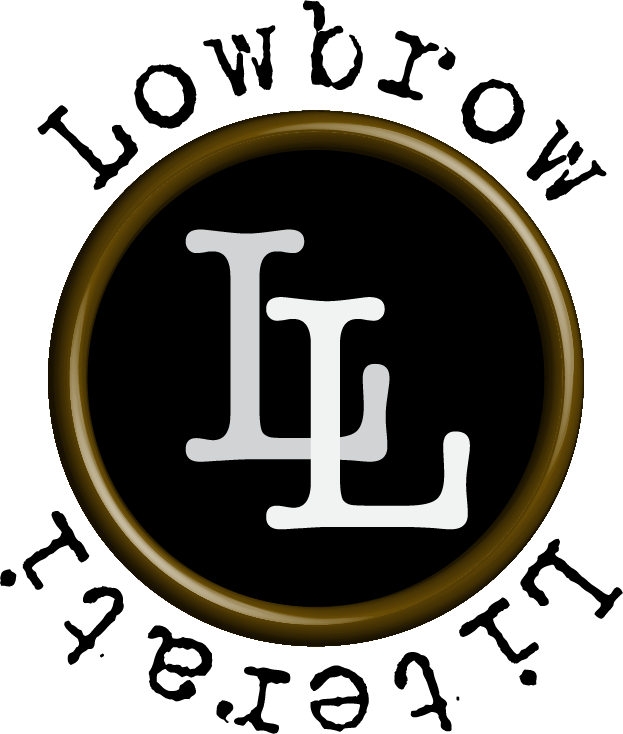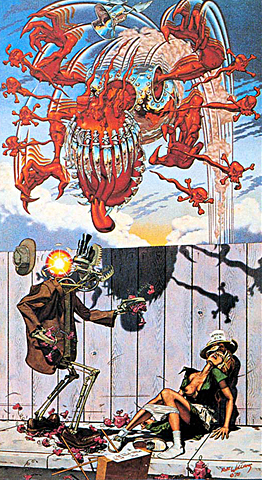
About
What is Lowbrow Art?
"Appetite for Destruction" by Robert Williams, 1978
What is lowbrow art?
Most American's have not heard of the Lowbrow art movement, yet most of them have seen it or enjoyed it in one way or another. Take for example the very popular heavy metal band, Guns N' Roses and their 1987 debut album, "Appetite for Destruction." The album name and cover was based off a painting of the same title. The original 1978 painting and the subsequent album cover depicts a robotic rapist, an abused woman sitting on the side walk with her panties dropped to her ankles, and a red metallic avenger leaping from the fence. The album cover was so controversial that record stores refused to stock copies of it. Guns N' Roses' record company, Geffen Records, compromised by putting the offending cover on the inside and replace the cover with a cross and skulls of the 5 members.
The individual to laud or blame for "Appetite for Destruction" is a underground comic book illustrator-cum-fine artist named Robert Williams. During the early-60s Williams was the illustrator for Ed "Big Daddy" Roth's t-shirt and custom car design business.
Roth sold airbrushed t-shirts of grotesque caricatures of over-sized monsters driving under-sized representations of hot rods that Roth built at car shows and hot rod magazines such as Car Craft. The t-shirts were called "Weirdo shirts" and they became a craze; and Roth was at the forefront. When Roth's business closed in the mid-60s, Williams joined ZAP comix, a non-conformist anti-establishment underground comic book founded by a collective of artists which included: R. Crumb, S. Clay Wilson, Gilbert Shelton, Spain Rodriguez, Rick Griffin, and Victor Moscoso. During his tenure at Zap he created his trademark anti-hero, Coochy Cooty, who appeared on the pages of Zap many times. During the late-70s Williams founded a loose knit group of illustrator friends, which included: Matt Groening, The Pizz, Gary Panther, and Mike Kelley, and called themselves the Art Boys. Williams hosted these ad hoc art shows as an excuse to throw a party and each show had a theme. Everyone had to produce an art piece based on the theme with the caveat that the work had to be "thow-awayable." The intent of Williams was to take cartoon imagery and take it to the next level. He hoped to start an art movement based on underground comic book images, which were drawn on paper with pen and ink, and transpose them with oil onto canvas. It would take 20 years for the movement to take off.
Around the same time small underground galleries in LA and New York are showing this type of artwork, Williams' fellow ZAP Comix alumus, Gilbert Shelton co-owned a publication company named Rip Off Press, and offered to do an art book of Williams' work. Since no other sane publication company would dare take this challenge, the dilemma was what to name the book? On a lark Williams decided to go with the title, "The Lowbrow Art of Robert Williams," and the front cover was a painting of a robotic rapist, an abused woman a red metallic avenger. The book was released in 1982. He admits that the term "Lowbrow" was never intended to name the nascent art movement and was never a serious conjecture. But that's exactly what happened. The original connotation was to suggest that the self-deprecating title would eventually wear off and rise over time.
About the author
FRITZ K. COSTA
Fritz Costa was a former Anatomy college professor who now works for a pharmaceutical company managing "first in man" clinical trials. He just happens to be really passionate about art.
He was born in the Philippines and emigrated to the United States in 1986. He graduated from San Francisco State University with a bachelors degree in Physiology, and a masters degree in Biochemistry from the University of Southern California.
He has published 8 peer reviewed articles in top tier journals, and a book chapter on cancer research. He taught college level Anatomy & Physiology, and Molecular Biology for 6 years, then decided to transition to the pharmaceutical industry. He enjoys the science world, but also has a great passion for the arts.
Fritz lives in Los Angeles, California with his wife, and their two children. If not attending a gallery opening, you'll find him either at a tiki bar or a record store digging through crates of dusty vinyl.
Kirkus Review: 14Dec2020
Press release: 31Aug2020
Inside the Desert Oasis Room Podcast: 11Aug2020
Hart to hart podcast: 06oct2020
miss art world podcast: 11nov2020
Indi reader review: 07Dec2020
voyageLA: 09Nov2020




